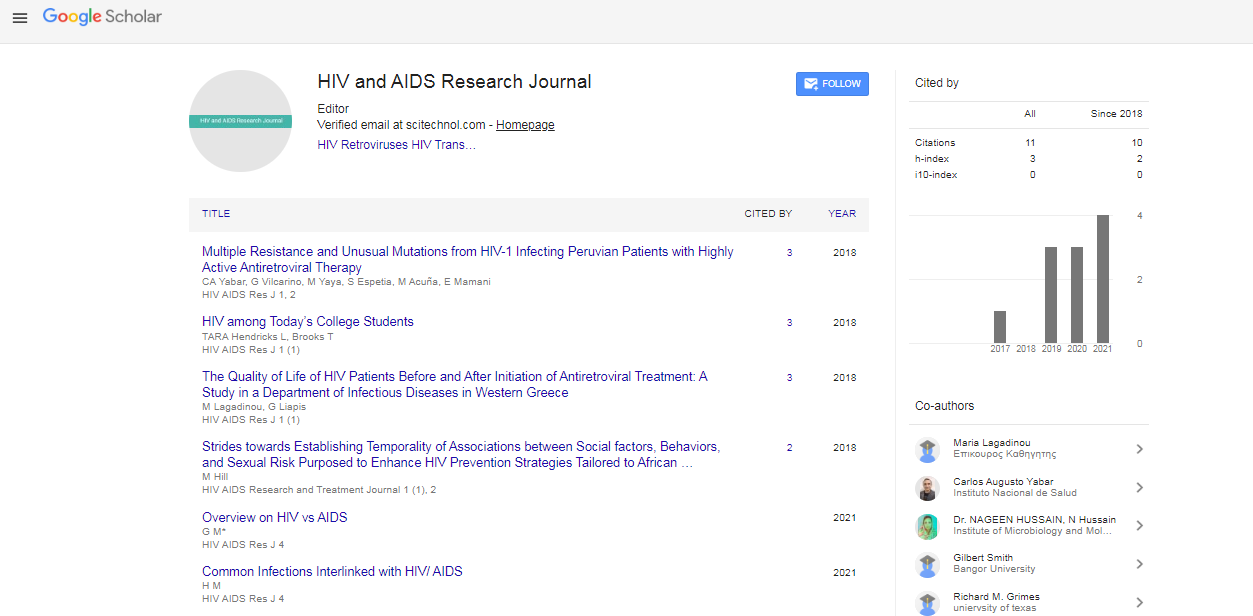Short Communication, Hiv Aids Res J Vol: 6 Issue: 4
Highly Active Antiretroviral Therapy: A Comprehensive Approach to HIV Treatment
David Nelson*
1Department of Global Health, University of Washington, Seattle, United States of America
*Corresponding Author: David Nelson,
Department of Global Health,
University of Washington, Seattle, United States of America
E-mail: david.nelson90k@gmail.com
Received date: 04 December, 2023, Manuscript No. HARJ-24-124126;
Editor assigned date: 06 December, 2023, PreQC No. HARJ-24-124126 (PQ);
Reviewed date: 20 December, 2023, QC No. HARJ-24-124126;
Revised date: 28 December, 2023, Manuscript No. HARJ-24-124126 (R);
Published date: 05 January, 2024 DOI: 10.4172/Harj.1000136
Citation: Nelson D (2024) Highly Active Antiretroviral Therapy: A Comprehensive Approach to HIV Treatment. HIV AIDS Res J 6:4.
Description
Highly Active Antiretroviral Therapy (HAART) has revolutionized the management of Human Immunodeficiency Virus (HIV) infection, transforming it from a fatal condition to a chronic, manageable disease. The discovery and development of Highly Active Antiretroviral Therapy (HAART) in the mid-1990s marked a pivotal moment in the history of HIV/AIDS treatment. HAART involves combining different classes of antiretroviral medications to suppress viral replication, preserve immune function, and prevent disease progression [1-4].
Components of HAART
HAART typically consists of a combination of at least three antiretroviral drugs from different classes. These classes include Nucleoside Reverse Transcriptase Inhibitors (NRTIs), Non-Nucleoside Reverse Transcriptase Inhibitors (NNRTIs), Protease Inhibitors (PIs), integrase inhibitors, and entry inhibitors. The rationale behind combining drugs from various classes is to target different stages of the viral life cycle, reduce viral load, and impede the development of drug resistance [5].
Mechanism of action
Each class of antiretroviral drugs exerts its effect by targeting specific viral enzymes or processes crucial for HIV replication. For instance, NRTIs and NNRTIs inhibit the activity of reverse transcriptase, an enzyme necessary for viral DNA synthesis. PIs prevent the cleavage of viral proteins essential for the formation of infectious viral particles. Integrase inhibitors block the integration of viral DNA into the host genome, while entry inhibitors impede viral entry into host cells [6-8].
Efficacy of HAART
The introduction of HAART has significantly improved the prognosis of individuals living with HIV/AIDS. Effective viral suppression achieved through HAART helps restore immune function, reduces HIV-related morbidity and mortality, and decreases the risk of transmitting the virus to others. With adherence to treatment regimens, many individuals on HAART achieve undetectable viral loads, leading to long-term viral suppression and improved quality of life.
Adverse effects
Despite the efficacy of HAART, these medications are associated with various adverse effects. Common side effects include nausea, diarrhea, fatigue, and metabolic abnormalities such as dyslipidemia and insulin resistance. Prolonged use of HAART can also lead to longterm complications like cardiovascular diseases, osteoporosis, and lipodystrophy. Adherence to treatment regimens is essential to minimize these adverse effects and maintain viral suppression [9].
Impact on HIV/AIDS management
HAART has transformed HIV infection from a once-debilitating disease with high mortality rates to a chronic, manageable condition. The widespread availability of HAART has led to a significant decline in HIV-associated deaths and opportunistic infections. Furthermore, HAART has played a crucial role in reducing the vertical transmission of HIV from mother to child during pregnancy, childbirth, and breastfeeding [10].
Conclusion
Highly Active Antiretroviral Therapy (HAART) stands as a cornerstone in the management of HIV/AIDS. Its effectiveness in suppressing viral replication, preserving immune function, and improving the quality of life for individuals living with HIV is undeniable. However, continued research is imperative to develop safer, more potent, and accessible antiretroviral therapies while addressing the challenges of long-term adverse effects and medication adherence.
In conclusion, HAART represents a remarkable achievement in modern medicine and remains instrumental in combating the global HIV/AIDS pandemic. Its ongoing refinement and accessibility are paramount in ensuring better outcomes and improved quality of life for individuals affected by HIV infection.
References
- Rehan M, Waheed U, Sarwar M, Arshad M, Satti HS, et al. (2016) Knowledge, Attitude, Practices and Awareness Regarding HIV/AIDS among University Students of Islamabad and Rawalpindi, Pakistan. Ann Pak Inst Med Sci 12: 34.
- Zuma K, Shisana O, Rehle TM, Simbayi LC, Jooste S, et al (2016) New insights into HIV epidemic in South Africa: key findings from the National HIV Prevalence, Incidence and Behaviour Survey, 2012. Afr J AIDS Res 15(1): 67-75.
[Google Scholar] [PubMed]
- Maartens G, Celum C, Lewin SR (2014). HIV infection: epidemiology, pathogenesis, treatment, and prevention. The Lancet 384(9939): 258-271.
[Google Scholar] [PubMed]
- Thorne C, Ferencic N, Malyuta R, Mimica J, Niemiec T, et al. (2010) Central Asia: hotspot in the worldwide HIV epidemic. Lancet Infect Dis 10(7): 479-488.
[Google Scholar] [PubMed]
- Coffin JM (1995) HIV population dynamics in vivo: implications for genetic variation, pathogenesis, and therapy. Science 267(5197): 483-489.
[Google Scholar] [PubMed]
- Fanales-Belasio E, Raimondo M, Suligoi B, Buttò S (2010) HIV virology and pathogenetic mechanisms of infection: a brief overview. Ann Ist Super Sanita 46: 5-14.
- Eaton JW, Hallett TB, Garnett GP (2011) Concurrent sexual partnerships and primary HIV infection: a critical interaction. AIDS Behav 15: 687-692.
- Janahi EM, Mustafa S, Alsari S, Al-Mannai M, Farhat GN, et al (2016) Public knowledge, perceptions, and attitudes towards HIV/AIDS in Bahrain: A cross-sectional study. J Infect 10(09):1003-11.
[Google Scholar] [PubMed]
- Hogan CM, Hammer SM (2011) Host determinants in HIV infection and disease: Part 1: cellular and humoral immune responses. Ann Intern Med May 134(9):761-76.
- Wyatt R, Kwong PD, Desjardins E, Sweet RW, Robinson J, et al. (1998) The antigenic structure of the HIV gp120 envelope glycoprotein. Nature 393(6686):705-11.
[Google Scholar] [PubMed]
 Spanish
Spanish  Chinese
Chinese  Russian
Russian  German
German  French
French  Japanese
Japanese  Portuguese
Portuguese  Hindi
Hindi 